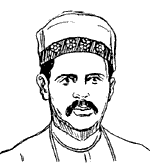|
 Indigo as a natural dye had been long known in the east and indigo was processed and used by Indians and excess production exported long before the arrival of the British. Indigo as a natural dye had been long known in the east and indigo was processed and used by Indians and excess production exported long before the arrival of the British.
The British planters started taking a keen interest in indigo when the supply of indigo from other sources dried up and India emerged as the largest exporter of the blue colour. The European planters induced Bengali peasants (ryots) to reserve a part of their land to grow indigo by making small payments as advance to be adjusted against final payment at the time of delivery.
The advance payment was the bait. Once the ryot took the bait and most of them did, he was hooked for life. His troubles began the moment he took his produce to the planter's factory. There, wrong measures were used to show that he had brought less than he claimed. The worth of his produce would be calculated at the rate of Rs.4 a maund though the market price was between Rs.10 and Rs.30 a maund. After deductions which included the value of the revenue stamps used in the agreement papers, the cost of seed supplied by the planter and transport charges the ryot would not only get nothing in hand but would actually end up owing money to the planter on account of the advance given to him.
The debt would increase over the years and would be passed down from father to son effectively binding the family to the planter. Even if a ryot somehow paid off his debt and sought to break away from the 'blue yoke' he was dissuaded from doing so by strongarm methods. Armed men called lathiyals would descend on him and beat him and his family and destroy his crops.
Complaining to the police or magistrates did not help — they were in league with the planters. The appointment of planters as honorary magistrates made matters worse. There was a strange case of a ryot's complaint against a planter being referred by the magistrate to that very planter who was then a honorary magistrate!
The ryots had a saying: Je rakhak se bhakak, 'our protector is also our devourer'.
Their rakhaks finally came – in 1858. In that year two brothers Bishu Charan Biswas and Digambar Biswas, who were employed by a planter, walked out of his indigo factory in disgust and persuaded the cultivators of their village, Chaugacha, to stop planting indigo. This passive resistance was met with brute force by the planters whose lathiyals plundered the village and burnt it. Undeterred by the threats held out by the planters, the Biswas brothers shifted women and children to a place of safety and employed armed men to protect the
ryots.
| 
